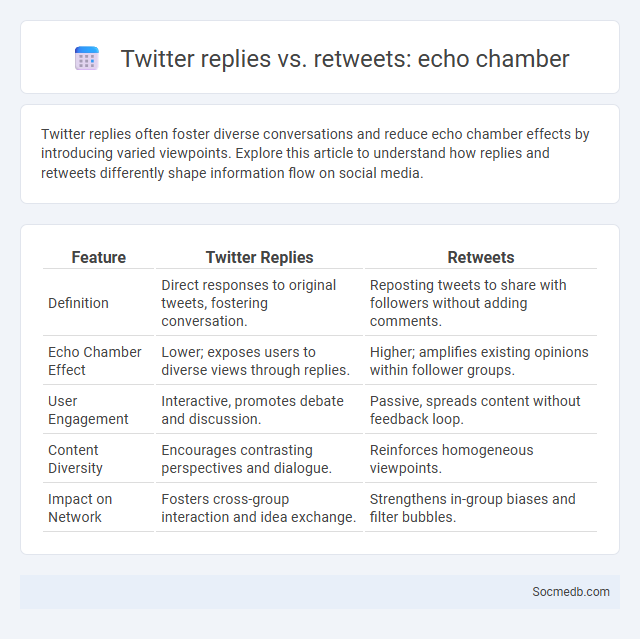
Photo illustration: Twitter replies vs retweets echo chamber
Twitter replies often foster diverse conversations and reduce echo chamber effects by introducing varied viewpoints. Explore this article to understand how replies and retweets differently shape information flow on social media.
Table of Comparison
| Feature | Twitter Replies | Retweets |
|---|---|---|
| Definition | Direct responses to original tweets, fostering conversation. | Reposting tweets to share with followers without adding comments. |
| Echo Chamber Effect | Lower; exposes users to diverse views through replies. | Higher; amplifies existing opinions within follower groups. |
| User Engagement | Interactive, promotes debate and discussion. | Passive, spreads content without feedback loop. |
| Content Diversity | Encourages contrasting perspectives and dialogue. | Reinforces homogeneous viewpoints. |
| Impact on Network | Fosters cross-group interaction and idea exchange. | Strengthens in-group biases and filter bubbles. |
Understanding the Twitter Echo Chamber
The Twitter echo chamber shapes your online experience by amplifying ideologically similar perspectives through algorithm-driven content feeds. This reinforcement limits exposure to diverse viewpoints, often deepening polarization and reducing critical engagement. Recognizing these patterns helps you navigate discussions more thoughtfully and seek balanced information on the platform.
The Dynamics of Twitter Replies
The dynamics of Twitter replies reveal complex interactions driven by user engagement patterns, algorithmic prioritization, and conversational context. Your ability to spark meaningful replies depends on crafting clear messages that encourage interaction and recognizing the influence of tweet timing and network connections. Understanding these elements helps optimize communication strategies to increase visibility and foster genuine dialogue on the platform.
Retweets: Amplification or Repetition?
Retweets serve as a powerful tool for amplifying your message across social media platforms, expanding reach beyond your immediate followers. This form of content sharing boosts visibility and engagement by redistributing original posts while maintaining the core message. Understanding the balance between amplification and mere repetition helps you strategically use retweets to enhance influence and avoid content fatigue.
Replies vs Retweets: Building or Breaking Echo Chambers
Replies foster direct conversations that challenge users to consider diverse perspectives, reducing the likelihood of echo chamber reinforcement by exposing individuals to contrasting opinions. Retweets primarily circulate existing viewpoints within like-minded networks, amplifying homogenous content and reinforcing confirmation bias. Understanding the dynamics between replies and retweets is crucial for designing social media platforms that encourage constructive dialogue and mitigate polarization.
How Echo Chambers Form on Twitter
Echo chambers on Twitter form as users engage primarily with like-minded individuals and content, reinforcing existing beliefs through algorithm-driven content curation. The platform's retweet and reply functions amplify homogenous viewpoints, while its recommendation system promotes similar content, increasing ideological segregation. This cycle limits exposure to diverse perspectives, deepening polarization and entrenching users within their own informational bubbles.
Comparing Engagement: Replies and Retweets
Replies on social media indicate active user involvement through direct conversation, reflecting deeper engagement with content. Retweets amplify content reach by sharing posts with a wider audience, focusing on distribution rather than personal interaction. Analyzing ratios of replies to retweets helps marketers identify content resonance and optimize strategies for community building versus brand awareness.
The Psychological Impact of Echo Chambers
Echo chambers on social media amplify confirmation bias, reinforcing users' preexisting beliefs and limiting exposure to diverse perspectives. This psychological effect can heighten polarization, increase anxiety, and reduce critical thinking skills by creating insulated environments where dissenting opinions are rarely encountered. Prolonged engagement within these echo chambers disrupts balanced information processing, impacting mental health and social cohesion.
Algorithmic Influence on Twitter Echoes
Twitter's algorithmic influence shapes your content exposure by prioritizing tweets based on engagement metrics like retweets, likes, and user interactions, often reinforcing existing beliefs. This feedback loop creates echo chambers where similar views dominate, limiting diversity of perspectives and promoting polarization. Understanding this dynamic empowers you to seek varied content intentionally, breaking algorithmic bubbles for a broader social media experience.
Escaping the Twitter Filter Bubble
Escaping the Twitter filter bubble involves actively seeking diverse perspectives beyond personalized algorithms that reinforce existing beliefs. Engaging with varied hashtags, following accounts across the ideological spectrum, and participating in open dialogues can broaden one's social media experience. This practice enhances critical thinking and reduces the risk of echo chambers influencing public opinion.
Strategies to Counteract Echo Chambers on Social Media
Effective strategies to counteract echo chambers on social media include actively diversifying your feed by following a wide range of sources and viewpoints, promoting critical thinking and media literacy skills to evaluate information objectively, and engaging respectfully with differing opinions to foster open dialogue. Algorithms can be adjusted to prioritize content variety, ensuring exposure to contrasting perspectives rather than reinforcing existing biases. These approaches empower you to navigate social media more thoughtfully and reduce the risks of confirmation bias and polarization.
 socmedb.com
socmedb.com